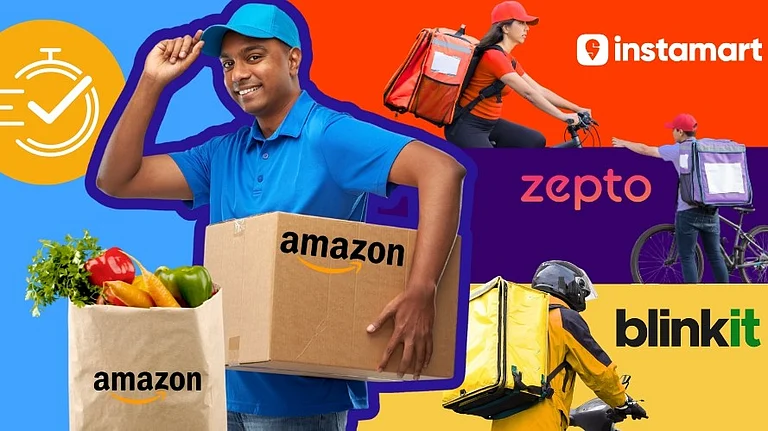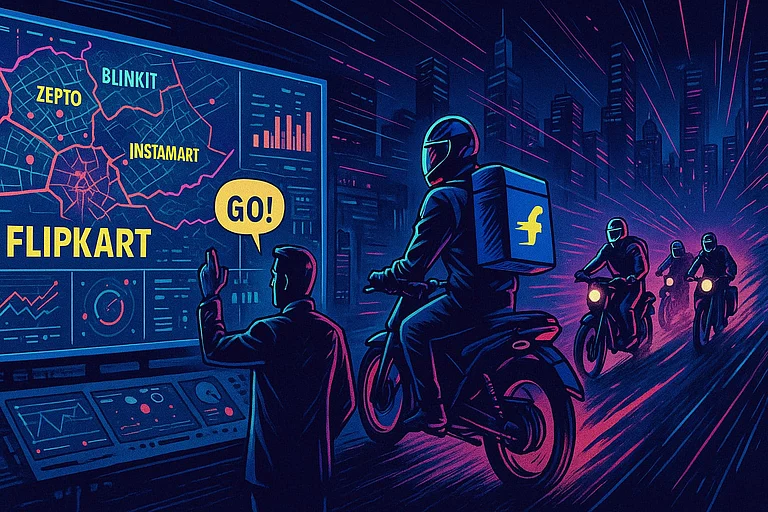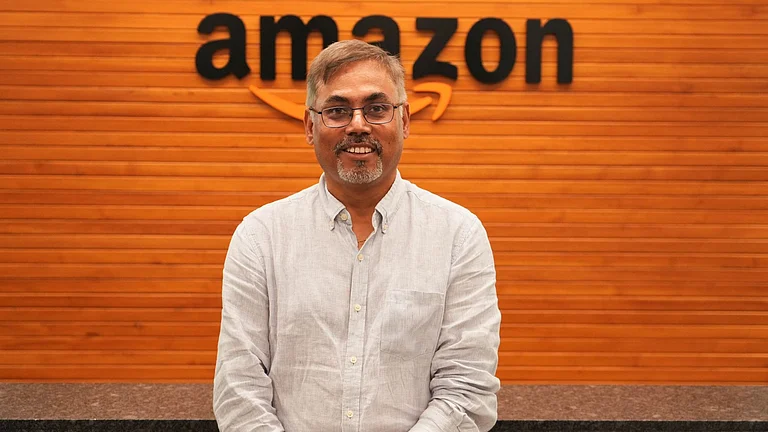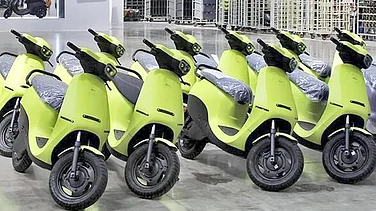
D2C brands are shifting sales from Amazon Fresh to quick commerce, with Jimmy’s at 40% and Better Nutrition at 65%
Quick commerce offers better fit for impulse buys, faster sampling, and real-time consumer insights
Founders say Amazon Fresh could bounce back with a 10-minute delivery model
Not long ago, Amazon Fresh contributed a small but steady share to cocktail-mixer brand Jimmy’s Beverages’ sales. Today, that number is nearly zero.
“Amazon Fresh used to contribute around 3–4% of our revenue, but now it’s almost nothing,” says Ankur Bhatia, founder of the brand. In its place, quick commerce has surged—from 10% of sales in 2022 to 20% last year and now 40%. “We’re not a grocery brand. We play in snacking and impulse, categories that fit quick commerce far better,” he adds.
Yet Bhatia believes that Amazon Fresh still holds potential, if it adopts a 10-minute delivery model, leveraging its vast customer base and catering to impulse buying.
Across India’s direct-to-consumer (D2C) landscape, this shift is becoming widespread. Better Nutrition, a digital-first brand that offers biofortified staples, now earns 65% of its revenue from quick commerce and only 25% from traditional e-commerce. “Amazon lets us bundle, but Blinkit lets us sample, experiment and get real-time, cohort-level data,” says cofounder and chief executive Prateek Rastogi.
Among D2C founders, there’s a growing consensus: Amazon and Flipkart have been slow to match the pace of quick commerce. “We’ve been in talks with Amazon for over six months,” says one founder on condition of anonymity. “But execution is slow. They haven’t scaled city-wise yet.” Flipkart, by contrast, is moving faster: “We are expected to go live on Flipkart Minutes within weeks,” says the founder.
Amazon entered the quick commerce space in June 2025 with the launch of Amazon Now in three Bengaluru pincodes and in Delhi. Flipkart, meanwhile, is already live in 19 cities.
Responding to a query from Outlook Business, an Amazon spokesperson said, “We are excited with the initial customer response and positive feedback, especially from Prime members. Based on this, we’re now expanding the service over the next few months.”
Meanwhile, Flipkart Minutes VP Kanchan Mishra told Outlook Business earlier, that while Flipkart Minutes may have been a late entrant to the quick commerce space, its pace of expansion has been remarkable. “The company has already crossed the halfway mark of its 800 dark store target…This is probably the fastest scale-up any quick commerce player in the country has achieved,” she adds.
Add to Cart
But the stakes are no longer limited to faster delivery. Quick commerce has rapidly evolved into an advertising platform and is becoming central to how brands reach and sell to consumers.
For digital-first brands operating on tight performance metrics, placements on platforms like Blinkit and Zepto now drive both sales and brand discovery. Meanwhile, both Amazon and Flipkart are under growing pressure to keep up.
“Quick commerce has evolved into a powerful brand discovery channel, almost like Instagram,” says Sreedhar Prasad, internet-business adviser and former partner at professional-services firm KPMG. A D2C chocolate brand, for instance, can now reach target customers more effectively on Zepto than on social media.
A product featured on Blinkit’s homepage in a prime slot can see sales lift overnight. The business model behind these placements is also becoming more structured, with Instamart offering tiered ad plans to brands that want to promote their products.
Brands, too, are diverting ad budgets in that direction. Jimmy’s Beverages, for example, now spends 30% of its gross merchandise value on quick commerce ads, citing a 4x return on ad spend, far higher than the 1.5x return on traditional e-commerce platforms.
Yet, as formidable as Blinkit and Zepto may seem, Amazon remains the gold standard in advertising infrastructure. “Amazon offers every format, banners, video, even off-platform advertising through its DSP [demand-side platform],” says Meher Patel, a former ad executive with the company.
“The biggest edge is in attribution. Amazon lets brands see exactly which ad led to a purchase, every keyword, every click. You don’t get that clarity on Blinkit or Zepto yet.”
Flipkart, in comparison, has stayed mostly within the confines of traditional e-commerce. Its video content initiatives never scaled, and ad placements remain restricted to its website. Yet, it remains indispensable for brands targeting Tier-II and Tier-III cities.
But advertising is gaining further traction inside Amazon. Sources say that internal targets have shot up in the past two years. “Last Diwali, the ad revenue target was ₹1,000 crore. This year, it was 25–30% more,” says a company insider. “Even if a brand pulled out, you were still expected to hit your number. There’s immense pressure.”
Cultural Conundrum
That pressure may partially explain why both Amazon and Flipkart are closely watching the quick commerce space, studying where Blinkit, Zepto and Instamart fall short—be it onboarding delays or high commission structures.
However, internal culture acts as a brake on both giants. At Amazon, every initiative, no matter how small, begins with a data-packed written memo. PowerPoints are banned and teams read the document before discussion. Even expanding a product category requires a two‑page (or longer) narrative detailing goals, forecasts and customer impact.
The fact that both Amazon and Flipkart report to global headquarters—Seattle and Bentonville— only adds to the delay. Every India-specific initiative must clear global oversight and align with broader corporate strategy.
Flipkart suffers from its own brand of legacy friction. Sources describe the company as top-down and dependent on centralised decision-making. Multiple insiders also say that chief executive Kalyan Krishnamurthy has long been sceptical of quick commerce, citing profitability and inventory‑wastage concerns, a hesitation that has kept momentum in check.
On the other hand, at a quick commerce platform say Zepto, It’s much faster. You can pitch an idea directly to the leadership, and if they’re convinced, you can go live in a week or 10 days, says a source.
And yet despite these hurdles, the parent companies—Amazon Inc and Walmart—have poured in large amounts of capital to bolster their India operations. In June 2025, Amazon earmarked ₹2,000 crore ($233mn) to strengthen its supply chain in India, tech capabilities and associate well-being. This was part of a pledge by chief executive Andy Jassy to raise Amazon’s total India investment to $26bn by 2030.
But a closer look reveals priorities. Amazon has consistently favoured its cloud business and India is no exception. Amazon Web Services (AWS), the company’s cloud-computing platform, is slated to invest $8.2bn in Maharashtra alone, part of a $12.7bn commitment across the country to support demand for AI and cloud infrastructure. In contrast, e-commerce and logistics receive less capital.
Profitability Pressures
In 2018, Walmart made a bold international bet, acquiring a 77% stake in Flipkart for $16bn. The intent was clear: to outpace Amazon in one of the world’s fastest-growing e-commerce markets. Amazon, in turn, had already been focused on investing in India. By 2019, it had spent over $5.5 billion since entering the market six years earlier and continued to put in money regularly.
Yet profitability has remained out of reach for both players.
An Outlook Business analysis of Amazon’s key India entities—Amazon Pay, retail, wholesale and transportation—from financial year 2016 to financial year 2024 shows losses across most units. Amazon Wholesale briefly turned a profit in financial year 2021 but soon slipped back into the red. While Amazon Pay has begun narrowing its losses, the rest still burn cash, reflecting the high cost of scaling in a low-margin, high-expectation environment.
Flipkart’s core businesses, too, are growing in revenue but remain far from profitable. Myntra is the rare exception, recently turning a profit and signaling operational improvement. Cleartrip, on the other hand, has posted widening losses, especially in the last year.
In this scenario, both companies have forayed into high-burn verticals—grocery, fintech and travel—with mixed results. Several bets, including Amazon Pantry and Amazon Academy, have been scaled back or deemed commercially unviable. As order values remain average, logistics costs rise and customer expectations spike, the pressure to find sustainable growth is intensifying.
“Amazon’s India marketplace remains loss-making primarily due to the high cost of building infrastructure from scratch and customer acquisition cost,” says Satish Meena, founder of Datum Intelligence, a market-research firm.
Flipkart, which holds a stronger grip in categories like fashion and smartphones, faces similar hurdles. “If they miss the grocery customer, it’ll hurt their long-term trajectory, especially with an IPO [initial public offering] on the horizon,” Meena adds.
That IPO, once seen as imminent, now looks increasingly uncertain. In 2024, reports pointed to a listing “within the next 12–15 months,” aiming for late 2025 or early 2026. But in June 2024, Walmart’s executive vice-president Dan Bartlett publicly dialled back the urgency, stating that Flipkart’s IPO would likely take “a couple of years,” with no immediate rush.
The Legacy Challenge
But as Blinkit and Zepto expand into categories like electronics and mobiles, Amazon and Flipkart have little choice but to respond.
Once the disruptors of brick-and-mortar retail, Amazon and Flipkart now find themselves cast in the role of incumbents, sometimes even as “legacy brands.” It’s not as if the companies are strangers to disruption. Both have weathered waves of competition before, whether it was the rise of vertical specialists such as Nykaa and FirstCry or the ascent of social-commerce players like Meesho, which carved into their value-conscious consumer base.
But this time it is different, say analysts. The platforms will have to invest a lot to enter into the already established market of major quick commerce players.
“It won’t be cheap, potentially a billion to a billion-and-a-half dollars. But it’s doable considering the size of opportunity. However, their entry was more reactive than strategic,” says Sachin Dixit, lead internet-research analyst, JM Financial Institutional Securities, a broking-services firm.
This lag has forced both firms to rethink their culture and strategy.
At Flipkart, sources say the leadership’s focus has shifted to trimming costs. “Kalyan [Flipkart’s chief executive] has made it very clear that profitability can’t wait. There were internal reviews where he asked for losses to be reduced within a matter of days, not months or quarters,” he explains.
Amazon, too, is tightening its belt. Workloads have expanded as teams consolidate roles, and managers are being tasked with tracking profitability-linked key performance indicators (KPIs) such as cost per delivery, conversion rates and return ratios far more closely than before. “Everything is about justifying spending now, every rupee needs a return and that pressure is constant,” says a source.
Across both companies, it’s clear that the era of growth-at-any-cost is over and internal culture is moving decisively toward sustainable margins. Despite the shifts, few would write them off just yet. As rivals redefine consumer expectations, whether these giants can pivot fast enough without compromising their bottom line remains the big question.


































